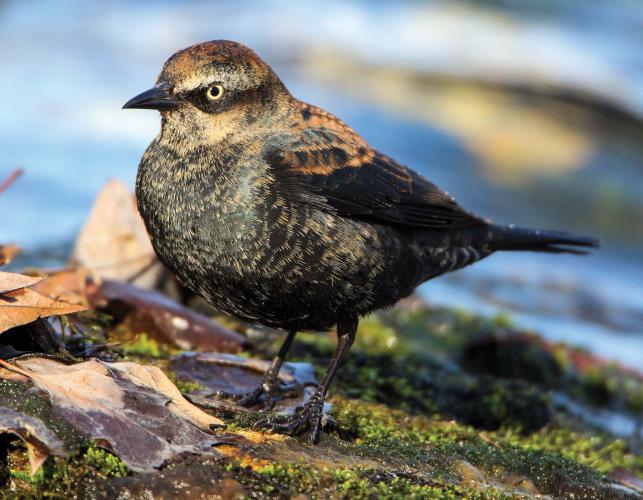Rusty Blackbird
A male rusty blackbird (Euphagus carolinus) forages bankside at Maramec Spring Park, near St. James. It was only by my forgetfulness that I was able to capture this image on a cold December day.
I had been photographing kingfishers all morning from a blind, and I decided to take a walk around the park in search of bald eagles and other critters. I stashed my gear under a bridge and began my walk. About an hour later, I decided to call it quits and headed to St. James for a late breakfast. Just as I pulled into town, I realized that I had forgotten my gear. Frustrated by my absent-mindedness, I turned around and headed back to Maramec Spring.
Upon return, I found the pile of equipment safe and sound where I had left it. I gathered it up and began walking back to my car at the park entrance. As I skirted the spring branch, I noticed some movement next to the water and saw that it was a lone rusty blackbird, searching for morsels next to a moss-covered riffle. I stowed my gear, for a second time, and ran back to my car to grab my camera, lens, and tripod. I knew there was a chance that the rusty might not wait for me, but it was worth a shot. When I finally made it back to the riffle, I found the busy blackbird right where I had left it, still foraging for insects next to the stream.
The rusty blackbird is an uncommon to rare winter resident, usually found near water, such as streams and wetlands, but it is also known to frequent fields and backyards when foraging with other species, such as grackles and cowbirds. In fall and winter, male rusties are distinguished by their rust-colored feather edges, pale yellow eyes, and tan eyebrows. While the male is dull black overall, the female is a lighter, gray-brown. Rusty blackbirds are often confused with grackles, which are larger with a longer tail.
Rusty blackbirds feed on insects, seeds, snails, and even small fish. I enjoy watching them flip leaves and detritus up in the air in an effort to reveal their prey. In east-central Missouri, where I do most of my photography, I’ve found rusties at Columbia Bottom Conservation Area, Riverlands Migratory Bird Sanctuary, Forest Park in St. Louis, and Maramec Spring Park. All of my encounters have been near water, and I’ve often photographed them in the water, sometimes in strong current. An intrepid little bird, rusties are undaunted by extreme conditions when searching for a meal.
I’ve been fortunate to observe and photograph rusty blackbirds in Missouri because the species is in rapid decline, to the consternation of birders and researchers alike. While factors such as habitat loss are suspected, the decline of the rusty blackbird is still under investigation. In the meantime, I’ll keep my eyes open for more rusties and take every opportunity to share those encounters with others.
—Story and photograph by Danny Brown
We help people discover nature through our online field guide. Visit mdc.mo.gov/node/73 to learn more about Missouri’s plants and animals.


And More...
This Issue's Staff
Managing Editor - vacant
Art Director - Cliff White
Staff Writer/Editor - Bonnie Chasteen
Staff Writer - Jim Low
Photographer - Noppadol Paothong
Photographer - David Stonner
Designer - Stephanie Thurber
Circulation - Laura Scheuler






















